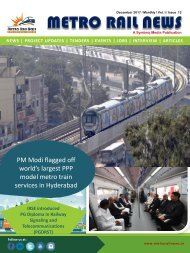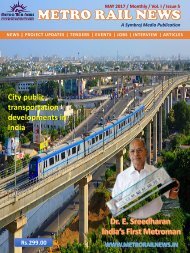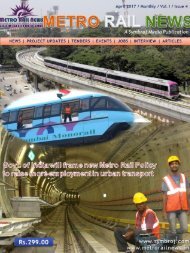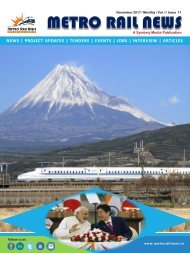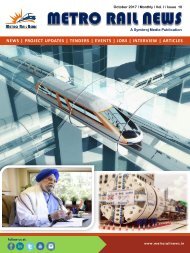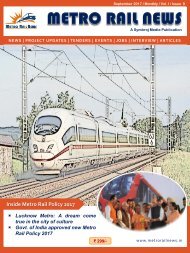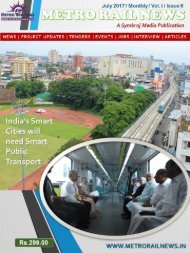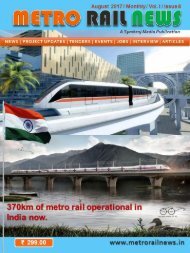Metro Rail News December 2016
Create successful ePaper yourself
Turn your PDF publications into a flip-book with our unique Google optimized e-Paper software.
Pollution and noise<br />
Highway noise and emissions<br />
from vehicles are recognized<br />
as pressing problems in urban<br />
areas. In order to reduce the<br />
noise impact, sound barriers<br />
may be erected, but the visual<br />
impact of such measures is<br />
major. It is often the case that<br />
residential property values<br />
near freeways are reduced due<br />
to high noise levels from cars<br />
and exhaust emissions. Also,<br />
there are associated health and<br />
safety issues for living close to<br />
a freeway.<br />
Once again, moving passenger<br />
transport from cars to mass<br />
transit systems can reduce the<br />
noise and pollution impact at<br />
the local level, but also at a<br />
larger scale as mass transit<br />
systems tend to be more<br />
energy efficient and substantial<br />
energy savings can be obtained<br />
by the increased use of metro<br />
systems.<br />
Alternatively, over the last few<br />
decades, many cities have<br />
constructed ring roads and<br />
roadway tunnels to improve<br />
their traffic conditions and to<br />
adapt the road network to the<br />
predicted demand. At the<br />
same time the travel times<br />
have improved and the impact<br />
of traffic on the surrounding<br />
residents has been reduced.<br />
Now, with city developments<br />
encroaching on existing ring<br />
roads, several cities have<br />
started to move surface<br />
sections of these ring roads<br />
below ground in order to<br />
further reduce their impact.<br />
Some examples are the doubledeck<br />
tunnels in the A86 in<br />
Paris, the large diameter<br />
tunnels for the M30 in Madrid<br />
or the cut-and-cover tunnels<br />
for the A10 in Amsterdam.<br />
An even greater impact on<br />
their surroundings may be<br />
caused by the elevated<br />
highways, mainly constructed<br />
in the 1950s and 60s in a<br />
number of, mainly US, cities;<br />
for example Boston, Seattle,<br />
and San Francisco. These giant<br />
elevated structures through<br />
down-town areas are now seen<br />
as unsightly, noisy, possibly<br />
unsafe, and provide only<br />
limited access to areas adjacent<br />
to the freeway. Many cities are<br />
considering or in the process to<br />
replace the elevated highways<br />
by urban road tunnels. An<br />
example is the Alaskan<br />
Highway in Seattle, which<br />
when completed will be the<br />
largest diameter bored tunnel<br />
in the world.<br />
These transitions from surface<br />
or above-surface roads to<br />
underground solutions in<br />
more or less the same location<br />
are often complex and costly.<br />
While the original decision to<br />
build these roads above<br />
ground often focused only on<br />
direct construction costs,<br />
decision makers should<br />
include real-estate impacts,<br />
ARTICLES |<br />
structural life span, and longterm<br />
sustainability when<br />
making such choices. This<br />
would help to avoid such<br />
unfavourable situations and<br />
reduce the life time cost of<br />
urban transport.<br />
Protection against natural<br />
disasters<br />
With concentration of<br />
population, urban areas are<br />
particularly vulnerable to<br />
failures in infrastructure due to<br />
ageing of the systems or those<br />
caused by other natural forces.<br />
Growth of population not only<br />
means more people are relying<br />
on the infrastructure, but at the<br />
same time that the man-made<br />
facilities may increase the<br />
severity of the disaster. For<br />
example, urbanization means<br />
more paved area leading to<br />
more severe flooding, as well<br />
as loss of water resources<br />
recharging groundwater.<br />
Underground rivers can be<br />
constructed to increase run-off<br />
or divert storm water. Large<br />
diameter tunnels have been<br />
bored below cities such as<br />
Buenos Aires and Tokyo for<br />
this purpose. The SMART<br />
tunnel in Kuala Lumpur takes<br />
this concept a step further, as<br />
this tunnel functions as a road<br />
tunnel during dry periods and<br />
is closed off for traffic and<br />
used as a storm-water tunnel<br />
during flooding periods.<br />
<strong>Metro</strong> <strong>Rail</strong> <strong>News</strong> | <strong>December</strong> <strong>2016</strong> | www.metrorailnews.in 49






